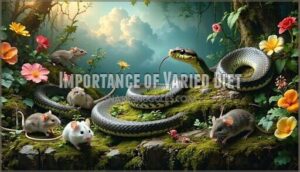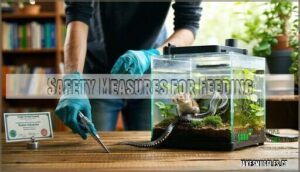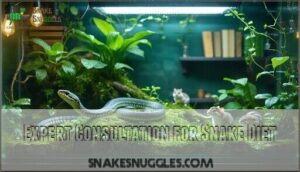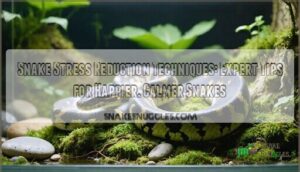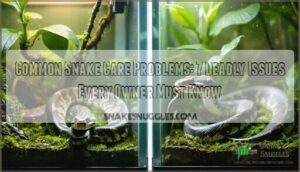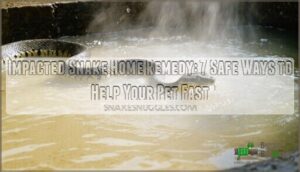This site is supported by our readers. We may earn a commission, at no cost to you, if you purchase through links.
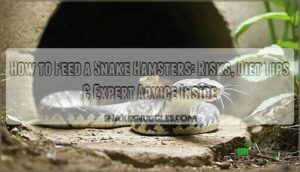 You’re considering feeding your snake hamsters, but it’s vital to understand the risks. Feeding hamsters to snakes can be done, but it’s not recommended due to potential health issues.
You’re considering feeding your snake hamsters, but it’s vital to understand the risks. Feeding hamsters to snakes can be done, but it’s not recommended due to potential health issues.
When learning how to feed a snake hamsters, research the proper techniques and precautions to guarantee a safe experience. However, it’s generally advised to stick to a more traditional snake diet.
You’ll want to explore alternative feeding options and understand the importance of a varied diet for your pet’s well-being, and that’s just the beginning of optimizing your snake’s nutrition.
Table Of Contents
- Key Takeaways
- How to Feed a Snake Hamsters?
- Feeding Hamsters to Snakes
- Why Hamsters Are Not Recommended
- Transitioning to Proper Snake Diet
- Importance of Varied Diet
- Safety Measures for Feeding
- Expert Consultation for Snake Diet
- Frequently Asked Questions (FAQs)
- Do snakes eat hamsters?
- What can a hamster eat?
- How do you feed a hamster a day?
- How often do hamsters eat?
- Can hamsters eat bananas?
- Do hamsters eat wet food?
- Can you feed a snake a hamster?
- How do you properly feed a snake?
- Are you supposed to feed a snake in its cage?
- Can you feed pet snakes live animals?
- Conclusion
Key Takeaways
- You’re considering feeding your snake hamsters, but it’s not recommended due to potential health issues, so you’ll want to explore alternative feeding options that meet your pet’s nutritional needs.
- When deciding what to feed your snake, you’ll need to prioritize a varied diet, as it’s essential for your pet’s well-being, and consider consulting an expert for personalized advice on feeding your snake.
- You’ll want to avoid feeding your snake hamsters because they pose health risks, including digestive issues and the transmission of diseases, and can also cause injuries with their sharp teeth and claws.
- If you’re looking for a safe and healthy alternative, you can feed your snake frozen-thawed prey, such as mice or rats, which are nutritionally superior and can help prevent health problems, and you should always handle prey safely using feeding tongs and monitor your snake’s health closely.
How to Feed a Snake Hamsters?
If you’re considering feeding snakes hamsters, hit the brakes. As far as Snake Nutrition goes, hamsters come with more baggage than benefits.
Their sharp teeth and claws can leave your snake nursing wounds, and hamster risks—like parasites and diseases—aren’t worth the gamble. Plus, hamsters as snake food just don’t meet the nutrition bill.
Instead, look to better prey selection and feeding alternatives like frozen mice or rats—think of them as the gold standard in snake food options. When offering food, use feeding tongs and watch closely.
Snake feeding techniques matter, especially while shifting away from feeding live prey. Keeping your pet’s Snake Health front and center always leads to better outcomes.
Understanding proper frozen mouse handling is vital for a snake’s digestive health.
Feeding Hamsters to Snakes
You’re considering feeding hamsters to your snake, but beware of the risks. Hamsters have sharp teeth and claws, posing a threat to your snake’s health.
Feeding hamsters to your snake comes with real risks—sharp teeth and claws can turn a meal into a health hazard.
They also lack essential nutrients like taurine and arachidonic acid, making them a less-than-ideal food source. Feeding hamsters to snakes can lead to digestive issues and health problems.
Instead, opt for alternative prey options like mice and rats, which are nutritionally superior. Remember, snake nutrition is key to your pet’s well-being.
Be aware of the hamster risks and consider the feeding ethics. Your snake’s digestive health depends on it. For a safe and healthy diet, research snake feeding guidelines to verify you’re providing the best nutrition for your pet.
Why Hamsters Are Not Recommended
You’re likely unaware of the numerous risks associated with feeding hamsters to snakes. Here are 5 key concerns:
- Hamster Risks
- Snake Nutrition
- Feeding Dangers
- Health Concerns
- Dietary Needs
Hamsters pose health risks, including digestive issues and the transmission of diseases. Their sharp teeth and claws can injure snakes, making them a dangerous choice.
Additionally, hamsters have high fat content, which can lead to obesity and other health issues in snakes.
It’s vital to prioritize animal welfare and consider alternative prey options to guarantee the well-being of your pet snake.
For proper snake care, consult a reptile vet expert to get personalized advice on nutrition and health.
Transitioning to Proper Snake Diet
Transitioning to a proper snake diet requires patience and persistence. You’ll introduce your snake to frozen-thawed prey alongside live offerings.
| Prey Type | Nutrition | Safety |
|---|---|---|
| Live | Variable | Risky |
| Frozen | Consistent | Safe |
| Alternative | Varied | Healthy |
Gradually increase the frozen food ratio, thawing it safely in the refrigerator. Monitor your snake’s health, seeking reptile nutrition advice if needed.
With proper snake nutrition and diet planning, you’ll guarantee a healthy snake diet. Explore prey alternatives and feeding techniques for a well-rounded approach to snake nutrition, including frozen prey and alternative prey options.
To achieve a successful shift, consider temperature control methods to mimic the natural environment.
Importance of Varied Diet
Without considering the complexity of snake nutrition, you’ll discover that varied diet isn’t just a nice-to-have—it’s absolutely essential for your snake’s well-being.
A varied diet fuels vibrant health, unlocking your snake’s full potential and vitality.
Think of snake nutrition like assembling a puzzle; each prey type contributes different pieces to complete the image of perfect health.
Balanced diets provide essential proteins, vitamins, and minerals that single-food sources simply can’t deliver.
Prey variety ensures your snake gets proper nutrient balance while supporting immune function and growth.
Different rodents offer unique nutritional benefits—rats provide excellent protein ratios, while mice offer different fatty acid profiles.
Your snake’s dietary needs change throughout its life, making diversity vital for long-term snake health.
Professional reptile nutrition advice consistently emphasizes rotating appropriate prey items rather than sticking to one type.
This approach prevents deficiencies and keeps your serpent thriving naturally—exactly what responsible snake owners want to achieve for their scaly companions.
By incorporating dietary variety into their feeding routine, owners can guarantee their snakes receive a broad range of essential nutrients.
Safety Measures for Feeding
Three critical safety measures protect both you and your snake during feeding sessions. Prey Handling requires feeding tongs to maintain safe distance from strikes, while Venom Safety means never assuming docility during meals. Feeding Risks multiply when supervision lapses.
Essential safe feeding practices include:
- Wear protective gloves to prevent bacterial transmission and potential bites
- Monitor continuously – choking hazard and Snake Injury occur when prey fights back
- Remove uneaten live prey immediately to prevent Digestive Issues and trauma
Health risks from improper feeding affect animal welfare long-term, making alternative prey worth considering. Understanding proper snake feeding techniques is vital for a healthy pet.
Expert Consultation for Snake Diet
Consult a reptile expert or veterinarian for a personalized feeding plan, ensuring ideal snake health and reptile nutrition.
They’ll guide you on diet planning, providing veterinary advice on feeding guidelines and snake nutrition facts.
With expert consultation, you’ll learn reptile care basics, create a suitable snake feeding schedule, and make informed decisions about your snake’s diet, prioritizing their well-being and health through proper nutrition and care.
Understanding the snake diet risks is vital for maintaining a healthy relationship between snakes and their food, and considering snake health is crucial.
Frequently Asked Questions (FAQs)
Do snakes eat hamsters?
You might think snakes eat hamsters, but surprisingly, they don’t typically prey on them in the wild, and feeding hamsters to snakes can pose health risks for the snake.
What can a hamster eat?
You can feed hamsters high-quality commercial pellets, limited fresh veggies, and occasional fruits, ensuring a balanced diet for ideal health and well-being, just like you plan their meals carefully.
How do you feed a hamster a day?
You’ll provide a balanced diet, about 1-2 tablespoons of food daily, depending on the hamster’s age, size, and activity level, ensuring they stay healthy and happy.
How often do hamsters eat?
You’ll find hamsters typically eat every 2-3 hours, so they need frequent, small meals throughout the day to stay healthy and happy, just like you need regular snacks.
Can hamsters eat bananas?
You can offer bananas to hamsters in moderation, as they’re a nutritious treat, but make certain they’re ripe and given in small amounts to avoid digestive issues.
Do hamsters eat wet food?
You’ll discover hamsters typically eat dry food, but they can have wet food as an occasional treat, helping to keep their diet interesting and preventing boredom.
Can you feed a snake a hamster?
You’re considering feeding a snake a hamster, but beware, it’s not a good idea due to potential injuries, diseases, and nutritional deficiencies for the snake.
How do you properly feed a snake?
You feed a snake by providing a varied diet of appropriately sized prey, such as frozen-thawed rodents, to guarantee nutritional needs are met, promoting healthy growth and well-being.
Are you supposed to feed a snake in its cage?
As the saying goes, "an ounce of prevention is worth a pound of cure." You’re usually not supposed to feed a snake in its cage to prevent escape and stress.
Can you feed pet snakes live animals?
You can feed pet snakes live animals, but it’s not recommended due to injury risks and nutritional deficiencies, opting for frozen-thawed prey instead is a safer, healthier alternative.
Conclusion
Notably, you’re now an expert on how to feed a snake hamsters.
You’ve learned it’s not the best option, but if you still want to try, remember to research proper techniques.
When considering how to feed a snake hamsters, prioritize a varied diet for your pet’s well-being, and don’t hesitate to consult an expert for personalized advice on feeding your snake.
- https://fluffytamer.com/snake-eat-hamster/
- https://everythingreptilion.com/can-snakes-eat-hamsters-the-answer-may-surprise-you/
- https://www.redtailboas.com/forum/boa-general-care-husbandry/feeding-issues/10214-are-hamsters-ok-to-feed-to-my-snake
- https://petfood.guide/hamster-snake-food/
- https://www.fieldherpforum.com/forum/viewtopic.php?t=19394


